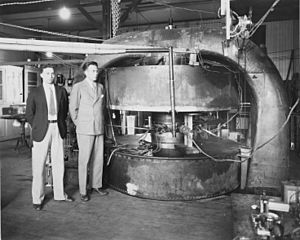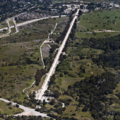Particle accelerator facts for kids

A particle accelerator is a powerful machine. It speeds up tiny pieces of matter, called particles, to incredibly high speeds. Think of it like a super-fast race track for atoms! These machines use electric fields to push particles, such as electrons, protons, or the centers of atoms (called atomic nuclei). They also use magnetic fields to guide them.
Scientists mainly use particle accelerators to study particle physics. This helps them learn about the smallest building blocks of the universe. The biggest accelerators explore particles even smaller than atoms. Smaller ones are used to study atomic nuclei or create radioactive materials.
There are two main types of particle accelerators:
- Linear accelerators move particles in a straight line.
- Circular accelerators make particles travel in a circle.
A famous example of a circular accelerator is the Large Hadron Collider at CERN. It is huge, stretching across two countries! Another example was the Tevatron in the United States. You might have even seen a particle accelerator in everyday life. Older televisions and computer monitors used a type of accelerator called a cathode ray tube.
Contents
How Particle Accelerators Work
When super-fast particles hit other particles, they can break apart. This helps scientists see even smaller pieces that are usually invisible. It's like smashing two toy cars together to see what they're made of!
This happens because movement energy can turn into matter at very high speeds. It's the opposite of what happens in nuclear weapons, where matter turns into energy. Sometimes, tiny amounts of antimatter are also created during these collisions.
Searching for New Particles
The particle accelerator at CERN was built to search for a special particle called the Higgs boson. Finding this particle helped scientists complete the "Standard Model of Particle Physics." This model helps explain how the universe works at its most basic level.
Cost and Technology
Particle accelerators use very advanced technology. This makes them quite expensive to build and run. Governments usually pay for these big projects.
Images for kids
-
The Tevatron (background circle) at Fermilab, a powerful particle accelerator. It was shut down in 2011.
-
Beamlines from a Van de Graaff generator leading to experiments in Paris.
-
Lawrence's 60-inch cyclotron in 1939. Scientists used it to discover plutonium and other elements.
See also
 In Spanish: Acelerador de partículas para niños
In Spanish: Acelerador de partículas para niños










